|
|
|
Sort Order |
|
|
|
Items / Page
|
|
|
|
|
|
|
| Srl | Item |
| 1 |
ID:
130885
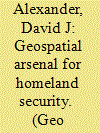

|
|
|
|
|
| Publication |
2014.
|
| Summary/Abstract |
Geospatial capabilities offer tremendous potential for driving new cost efficiencies and operational effectiveness for homeland security missions. Geospatial data and technology improve the ability of information technology applications and systems to enhance public security and provide for more effective situational awareness and delivery of a common operating picture. Geospatial information is often the common denominator that links disparate information together to reveal the necessary context and understanding required to connect the dots, and generate actionable information vital for effective decision-making. Location is everything to homeland security. Without geospatial context, we cannot understand where and how events are occurring, nor can we rationalise why they are occurring. The location component is the 'make or break' for nearly all homeland security operations from back office functions such as facilities management, to frontline operations in disaster response, border security, customs enforcement, critical infrastructure and threat reduction.
|
|
|
|
|
|
|
|
|
|
|
|
|
|
|
|
| 2 |
ID:
130882
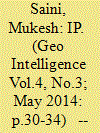

|
|
|
|
|
| Publication |
2014.
|
| Summary/Abstract |
Cyber warfare is very similar in nature to naval warfare. In international waters, navy encounters enemy warships, large merchant vessels, small merchant ships, fishing boats and guised surveillance ships from all directions. There are no borders to clearly establish that everything on the other side belongs to enemy. Though there are Sea-Lanes-of-Communication (SLOC) but two ports are actually on connectionless service and no ship is bound to follow SLOC. In cyberspace, IP address is the flag which every asset on the Internet displays but ruse is not uncommon. It is therefore necessary to identify the cyber assets positively in any cyber-conflict before any aggressive response is initiated. Wearing flag of convenience is common for sea vessels as well as cyber assets.
|
|
|
|
|
|
|
|
|
|
|
|
|
|
|
|
| 3 |
ID:
130886
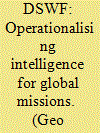

|
|
|
|
|
| Publication |
2014.
|
| Summary/Abstract |
GEOINT 2013* Symposium, organised annually by the United States Geospatial Intelligence Foundation (USGIF), was held at Tampa Convention Centre, Tampa, Florida, from April 14-17, 2014. The symposium, which is renowned for its keynote addresses, educational and training sessions and exhibition, provided an excellent opportunity for networking to the geointelligence community. The conference was originally scheduled to be held in October 2013. However, it had to be postponed due to the unprecedented US federal government shutdown. It was therefore held in April this year, with most of the original agenda intact. The symposium was spread over four days. Day 1, designated as Geoint Foreword, was the symposium's pre-conference session dedicated to innovation, emerging trends and academia. The session was introduced by Dr Darryl Mordock, Vice President Professional Development, USGIF. Dave Snowden, founder and chief scientific officer of the consulting firm Cognitive Edge (not to be confused with Edward Snowden!) delivered the first keynote. He suggested the use of human sensors from ordinary life to create a network. Open source data produced by human geography is valuable, he emphasised. This was followed by selected brief talks, called 'lightening talks', on subjects such as crowd sourced imagery, maritime geoint and race cars. The afternoon was dedicated to talks on subjects such as crowd sourced imagery, interoperability and special ops.
|
|
|
|
|
|
|
|
|
|
|
|
|
|
|
|
| 4 |
ID:
130883
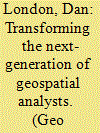

|
|
|
|
|
| Publication |
2014.
|
| Summary/Abstract |
It's been ten years since the 2004 National Defense Authorization Act was signed, officially coining the term 'GEOINT'. Today, GEOINT has become such a focus of national defence that the supply of analysts simply cannot meet the demand for imagery products. Almost every intelligence report requires, or could be enhanced by, some geospatial imagery component. As a result, geospatial intelligence software companies like ours have been hard at work developing full suites of integrated geospatial products capable of being used by any analyst, anywhere, at any time. Rather than transforming, through retraining, all-source analysts into geospatial experts, with the right tools, we can empower these talented and experienced all-source analysts to easily extract their own imagery to complete their intelligence products, freeing up the geospatial imagery experts to focus their attention on processing and exploiting more complex geospatial data. To do this, we set out to develop a lightweight, intuitive Web-based Electronic Light Table that would enable any all-source analyst to easily locate imagery, maps, vectors or text reports so they can build their daily intelligence reports or briefings.
|
|
|
|
|
|
|
|
|
|
|
|
|
|
|
|
| 5 |
ID:
130881
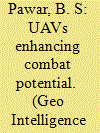

|
|
|
|
|
| Publication |
2014.
|
| Summary/Abstract |
Information is an element of combat power and a combat multiplier in the hands of a commander. Field commanders require an organic, responsive, economically viable, multi- source, long endurance, near real-time reconnaissance capability to collect, process and report intelligence throughout the level of conflict. Additionally, commanders need ability to obtain data from anywhere within enemy territory, day and night (24x7), regardless of weather. The answer lies in the use of UAVs, with their inherent characteristics to provide the flexibility to operate in the extended battle space, thereby enabling the ground forces to see first, understand first, act first and finish decisively. UAVs are remotely piloted or self piloted aircraft that can carry cameras, sensors, communication equipment or other payloads. They have been used in the reconnaissance and intelligence gathering role from 1950s; and more challenging roles are envisaged including combat missions. Unmanned vehicles are not impeded by restraints imposed on manned systems, where both the aircraft and crew could be lost. In fact, they are increasingly being employed for missions that were hitherto the domain of manned aircraft. The UAVs today are also providing exclusive capability to forces engaged in sub-conventional operations, especially in the global war on terrorism - in Afghanistan and Pakistan.
|
|
|
|
|
|
|
|
|
|
|
|
|
|
|
|
|
|
|
|
|